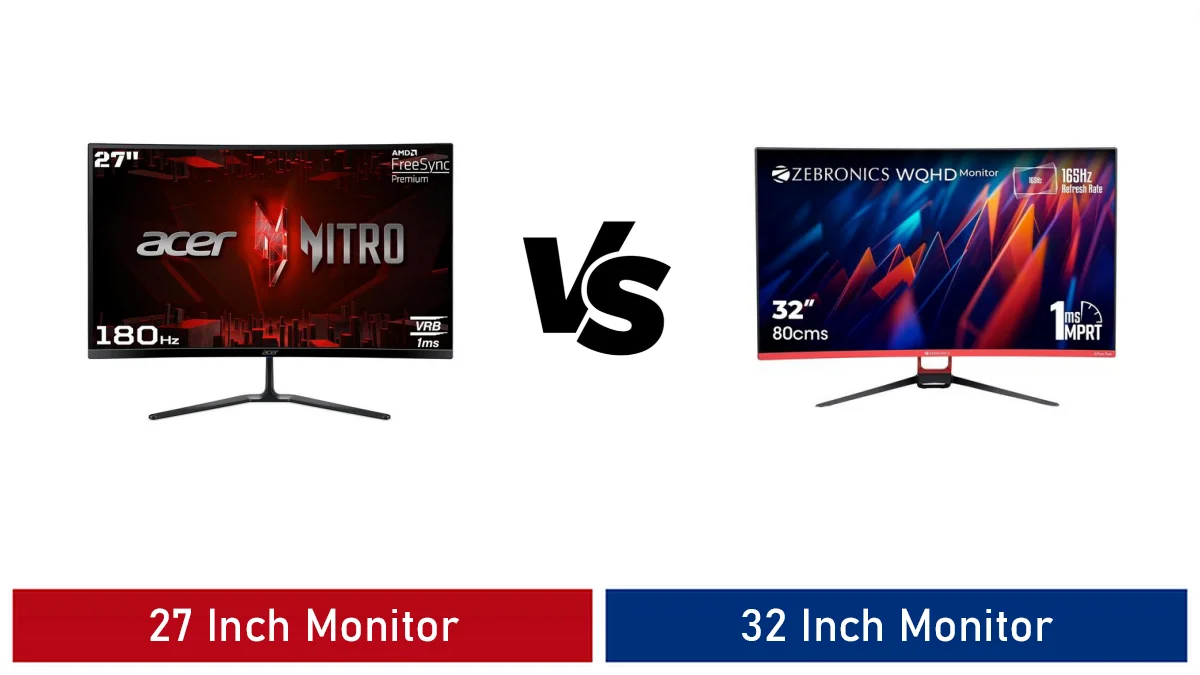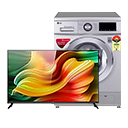
27 Inch vs 32 Inch Monitor – Monitors are the windows to our digital world, impacting our work, gaming, and entertainment experiences.
Choosing the right monitor size is a crucial decision, and in this comprehensive comparison, we’ll explore the differences between 27-inch and 32-inch monitors to help you make an informed choice.
Contents
- 1. Screen Size and Physical Dimensions
- 2. Resolution and Pixel Density
- 3. Gaming and Multimedia Experience
- 4. Productivity and Multitasking
- 5. Price Considerations
- 6. Ergonomics and Comfort
- 7. Space Constraints and Room Setup
- 8. Graphics Design and Visual Professionals
- 9. Final Verdict
- 10. Conclusion
- 11. 27 Inch vs 32 Inch Monitor FAQs
1. Screen Size and Physical Dimensions
1.1 Definition of Screen Size
Screen size is typically measured diagonally from one corner of the display to the opposite corner.
A 27-inch monitor and a 32-inch monitor refer to this diagonal measurement, which significantly affects the viewing experience.
1.2 Comparison of Physical Dimensions
Let’s compare the physical dimensions of these two monitor sizes:
27-Inch Monitor:
- Width: Approximately 23.5 inches
- Height: Approximately 13.2 inches
32-Inch Monitor:
- Width: Approximately 28.1 inches
- Height: Approximately 15.8 inches
The key takeaway is that a 32-inch monitor is physically larger than a 27-inch monitor. This size difference influences your desk space and overall setup.
2. Resolution and Pixel Density
2.1 Explanation of Resolution
Resolution refers to the number of pixels that make up the display, impacting image clarity and detail.
Both 27-inch and 32-inch monitors come in various resolutions, including Full HD (1920×1080), 2K (2560×1440), and 4K (3840×2160).
2.2 Pixel Density and Its Significance
Pixel density, measured in pixels per inch (PPI), is crucial for image sharpness. Smaller monitors with the same resolution as larger ones will have higher pixel densities, resulting in crisper text and more detailed images.
Here’s a comparison of pixel densities for a 27-inch and a 32-inch monitor, both with a Full HD (1080p) resolution:
| Aspect | 27-Inch Monitor (1080p) | 32-Inch Monitor (1080p) |
|---|---|---|
| Pixel Density (PPI) | Lower | Lower |
Both monitor sizes with a Full HD resolution offer lower pixel densities, meaning text and images may appear slightly less sharp compared to smaller monitors with the same resolution.
3. Gaming and Multimedia Experience
The size of your monitor significantly impacts your gaming and multimedia experiences. Let’s explore the implications of screen size in these scenarios.
3.1 Refresh Rates and Response Times
Both 27-inch and 32-inch monitors can offer varying refresh rates and response times, affecting gaming performance.
Smaller monitors often excel in response times, making them ideal for competitive gaming.
3.2 Immersion and Field of View in Gaming
A larger 32-inch monitor can provide a more immersive gaming experience, thanks to its larger display area.
Gamers appreciate the increased field of view, enhancing situational awareness in games.
3.3 Impact on Video Editing and Multimedia Tasks
Larger monitors, like 32-inch displays, are beneficial for video editing, graphic design, and multimedia tasks.
The extra screen real estate allows for better multitasking, which is essential for content creators.
4. Productivity and Multitasking
For productivity-focused tasks, such as work and content creation, monitor size significantly impacts your efficiency.
Let’s examine how screen size affects productivity and multitasking.
4.1 Screen Real Estate for Work
A 32-inch monitor provides more screen real estate, allowing you to view larger documents, spreadsheets, and web pages without constantly zooming in or scrolling. This can enhance your productivity by reducing interruptions.
4.2 Split-Screen and Multitasking Capabilities
Larger monitors excel in split-screen multitasking. You can comfortably view and work with multiple applications side by side, making tasks like research, coding, and content creation more efficient.
4.3 The Role of Screen Size in Content Creation
Content creators often prefer larger monitors for video editing, graphic design, and 3D modeling tasks.
The larger canvas provided by a 32-inch monitor can accommodate intricate design work without the need for frequent zooming.
5. Price Considerations
Price considerations are vital when choosing a monitor. Let’s explore the price ranges for 27-inch and 32-inch monitors and their value for money.
5.1 Price Comparison for Similar Configurations
- 27-Inch Monitor: These monitors typically offer a wide range of prices, making them suitable for various budgets. Prices can vary based on resolution, panel type, and additional features.
- 32-Inch Monitor: Larger monitors, including 32-inch models, tend to be more expensive than their 27-inch counterparts, especially when they feature higher resolutions or advanced technologies.
5.2 Value for Money and Budget Constraints
27-inch monitors provide excellent value for money, offering a balance between screen real estate and cost.
They are suitable for budget-conscious users who want a larger display without a substantial price increase.
On the other hand, 32-inch monitors, while pricier, offer a more immersive experience and enhanced productivity, justifying the higher cost for users who prioritize those benefits.
6. Ergonomics and Comfort
Ergonomics and viewing comfort are essential factors, particularly for users who spend long hours in front of their monitors.
6.1 Viewing Distance and Ergonomics
The viewing distance should be comfortable, with the monitor positioned at eye level to reduce neck strain.
Larger monitors may require a slightly greater distance for an optimal viewing experience.
6.2 Eye Strain and Comfort Factors
Proper ergonomics, including adjustable stands and blue light filters, can help reduce eye strain, regardless of screen size.
Smaller monitors may require closer viewing, potentially leading to more eye strain during extended use.
6.3 Adjustability Options for Different Screen Sizes
Both 27-inch and 32-inch monitors can come with adjustable stands, allowing you to customize the viewing angle and height.
Adjustable stands enhance comfort and ergonomics, regardless of the screen size.
7. Space Constraints and Room Setup
Your available desk space and room setup can significantly influence your choice of monitor size.
7.1 Assessing Available Desk Space
Measure your desk space to ensure that the chosen monitor size fits comfortably without crowding other peripherals or items.
Smaller desks may benefit from 27-inch monitors to maximize space efficiency.
7.2 Room Size and Viewing Distance
Consider the size of the room and your preferred viewing distance from the monitor. A larger room may accommodate a 32-inch monitor with a suitable viewing distance.
7.3 Choosing the Right Size for Your Environment
Ultimately, your room setup and available space should guide your decision. Ensure that the monitor size complements your room’s aesthetics and layout.
8. Graphics Design and Visual Professionals
For graphic designers, visual artists, and professionals in similar fields, the choice of monitor size significantly impacts their work.
8.1 Requirements for Graphic Designers
Graphic designers often require larger monitors with high resolutions for precise and detailed work.
A 32-inch monitor with a 2K or 4K resolution can be an excellent choice for professionals in this field.
8.2 Benefits of Larger Screens for Visual Professionals
Larger screens offer more room for toolbars, palettes, and multiple windows, enhancing workflow efficiency.
The larger canvas provided by a 32-inch monitor can accommodate intricate design work.
8.3 Balancing Performance and Desk Space
While larger monitors provide numerous benefits for visual professionals, consider the available desk space and ergonomics.
Ensure that the monitor size aligns with your workspace without sacrificing comfort.
9. Final Verdict
In summary, the choice between a 27-inch and a 32-inch monitor ultimately depends on your specific needs, preferences, and budget:
- 27-Inch Monitors: These monitors offer a balanced combination of screen real estate and affordability, making them suitable for a wide range of tasks and budgets.
- 32-Inch Monitors: Larger monitors provide an immersive experience, enhanced productivity, and are ideal for users who prioritize a spacious display and are willing to invest a bit more.
10. Conclusion
Selecting the right monitor size is a personal decision, influenced by your unique requirements and preferences.
Whether you opt for a 27-inch or a 32-inch monitor, both sizes have their advantages. By carefully considering factors such as your workspace, viewing comfort, budget, and intended usage, you can make an informed choice and elevate your digital experience.
11. 27 Inch vs 32 Inch Monitor FAQs
What are the main differences between 27-inch and 32-inch monitors?
The main differences between 27-inch and 32-inch monitors include screen size, resolution, viewing distance, and workspace requirements.
A 32-inch monitor offers a larger screen size, providing a more immersive experience for gaming, content consumption, and multitasking. It may also have a higher resolution to maintain image quality on the larger display.
A 27-inch monitor is more compact and suitable for smaller workspaces or those who prefer a standard monitor size.
Is a 32-inch monitor better for gaming and multimedia consumption?
A 32-inch monitor can provide a more immersive gaming and multimedia experience due to its larger screen size.
It allows for better immersion in games and provides a larger canvas for watching movies or editing videos. However, the choice between a 27-inch and 32-inch monitor for gaming also depends on factors like resolution, refresh rate, and personal preferences.
Are 32-inch monitors suitable for office work and productivity?
32-inch monitors can be suitable for office work and productivity tasks, especially if you require a larger workspace for multitasking or need to view multiple windows simultaneously.
The larger screen allows for better organization of documents and applications. However, consider your available desk space, as a 32-inch monitor may require a larger desk.
Do 27-inch monitors offer better pixel density and image sharpness?
In most cases, a 27-inch monitor with the same resolution as a 32-inch monitor will have a higher pixel density, resulting in crisper and sharper images.
If you prioritize image sharpness for tasks like photo editing or text-intensive work, a 27-inch monitor with a higher resolution may be a better choice.
What should I consider when choosing between a 27-inch and 32-inch monitor?
When choosing between a 27-inch and 32-inch monitor, consider factors such as your available desk space, viewing distance, intended use (e.g., gaming, productivity, content consumption), and personal preferences for screen size and image sharpness.
It's also essential to check the monitor's resolution and pixel density to ensure it meets your needs.
|
Related Tags
27 inch vs 32 inch monitor reddit, 27 inch vs 32 inch monitor gaming, 27 inch vs 32 inch monitor for work, 27 inch vs 32 inch monitor for programming, 27-inch vs 32 inch monitor for photo editing, 27 vs 32 monitor 4k
Last update on 2024-05-11 at 16:46 / Affiliate links / Images from Amazon Product Advertising API












